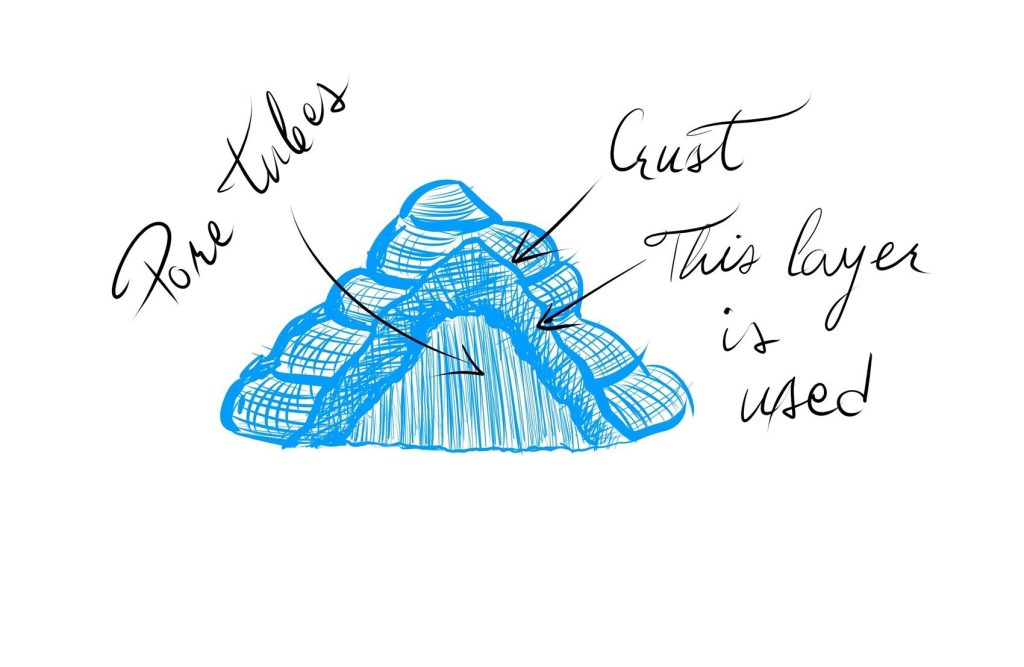Using flint and steel to light a fire is a method that has been around for a long time, and you can say it stood the test of time in that sense.
For this method you will need the following items:
- Steel striker
- Flint
- Charcloth or Tinder Fungus

STEEL STRIKER
Steel striker is the only item here that would be hard to replace with a substitute from nature, so you should take care not to lose it.
Steel striker is made from high carbon steel that is hardened. It is important that the steel used has a high carbon content, lower carbon content will result in fewer sparks (shouldn’t have below 0,6% carbon). Metal files are often used for this purpose but if you want to make it from new steel you can use something along the line of 1095, O1, W1…
PYRITE
Pyrite is a historic substitute for steel striker because obviously, cavemen didn’t have heat-treated steel to use, so they found that by striking pyrite with flint you can get sparks that are a bit harder to catch than from steel striker but with practice, it can be done.
Pyrite is a mineral also called iron pyrite and by its nickname fools gold. It is one of the most common sulfates minerals and it can be usually found alongside chert quartz veins, sedimentary rocks, and metamorphic rocks, as well as in coal beds
FLINT
Flint is a term for a rock that is in the category of chert, which is basically quartz rock with impurities in it. What makes it special is that it is harder than steel itself. So in theory you don’t really need flint but you need a rock that is harder than steel.
A lot of the rocks even though they are not chert will have a part of them that contains quartz so even though you may not have flint with you you can almost always find it while you walk through the woods.
CHAR CLOTH
Char cloth is a term for a tinder that is used to catch sparks when you hit flint with a firestriker. The char cloth is made from typically cloth in a process that is the same as making charcoal from wood called pyrolysis.
Basically, you make it by placing a cloth made from organic material such as cotton in a sealed metal container (like from airgun pellets) with only a small hole in it and then placing it on coals or fire and waiting for it to turn into char cloth. Usually, you can tell that it is done when the fire stops coming out of that small hole.
TINDER FUNGUS
Tinder fungus also called a Hoof fungus (Fomes Fomentarius) is a fungus that has been used for centuries as a tinder. Because of its fibrous structure when prepared the right way it can easily catch a spark.
But before it can be used it needs to be processed into something called Amadou. It basically means that you extract the trama layer of fungus which has those fibrous and fluffy properties, and then you boil it for a long time (between a few hours and a few days, basically the more you boil it the better it gets) and after that, you flatten it gently with a wooden hammer. Then you kinda stretch it and bend it with your hands to tease those fibers out.
It seems complicated and it probably is, you are better off just using char cloth but if you want to try this method out go for it.

How to light a fire using flint and steel
For explanation, I will be using char cloth but the principle is the same. First, you place your charcloth on top of the piece of flint, you should position your flint in a way so that a sharp edge on the flint will come in contact with steel when it is struck by it. Think of it like you are sharpening your knife but the sharpening stone is the steel and your knife is a piece of flint.
After you have placed everything in the correct position you can strike your flint with steel and you should see sparks flying in usually upwards direction, because of that the char cloth is placed on top.
Continue to strike it with a steel striker until the charcloth catches a spark and begins to ignite. After that place, the char cloth in a tinder bundle of some sort (dried grass, dead leaves, dried cedar bark…), and after that blow in it and you should see your fire starting to form, from there on just build your fire using progressively bigger pieces of kindling and you are good to go.

Bonus TIP
As I was doing research myself and what other people say about flint and steel I came across a post about using flint and steel to light a fire using tinder that you haven’t previously prepared but by using plants around you and drying them in a sun for a bit or using dead parts of the plant and I have to share it with you, because this could change the game for flint and steel as it was previously thought that you can’t use this method for starting a first fire.
Watch that video here: https://www.youtube.com/watch?v=Zkr5pi_Augs
Conclusion:
Lighting a fire with flint and steel is a fun, sometimes challenging method, and in that way is a great skill that you should learn and practice no matter if you are just camping, doing bushcraft, or in a survival situation. With a little bit of practice and patience, you will be able to consistently light a fire time and time again and that is always a good thing.
If you like this post please share it!
SIMILAR POSTS:
Fatwood – Why Should You Know About This Firestarter?
Bushcraft stoves – Stay warm and feed!

Pingback: Knife Batoning - Everything you need to know - Bushcraft Empire